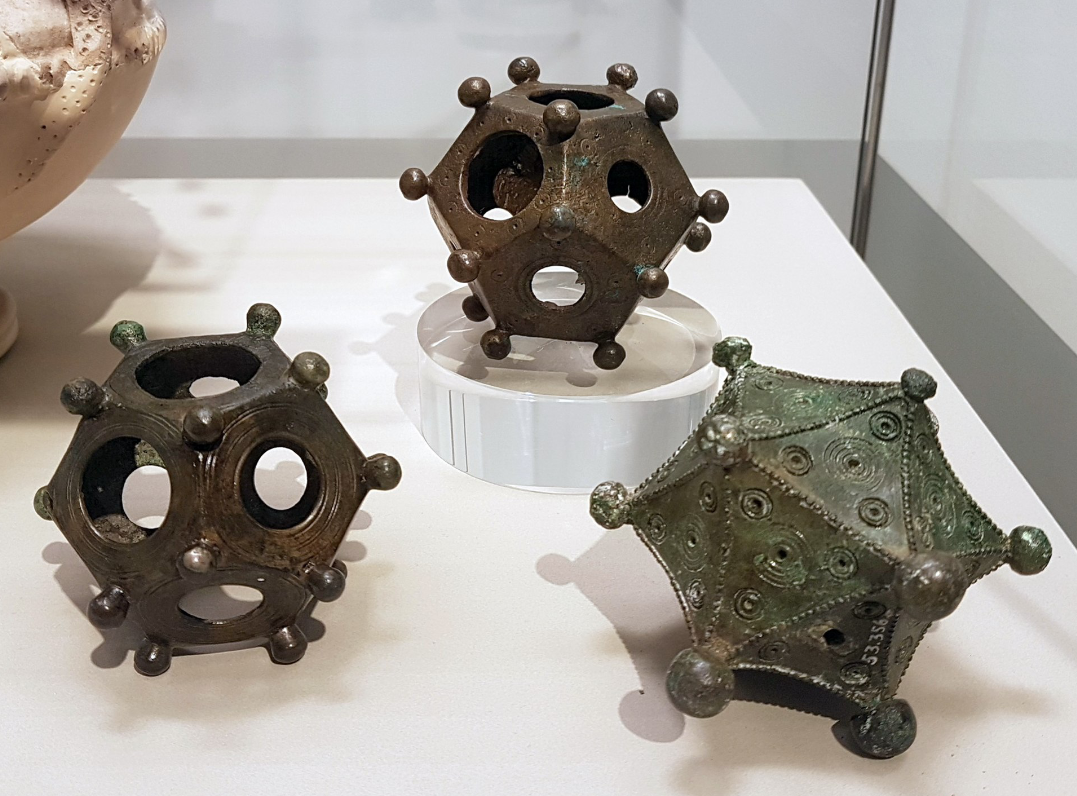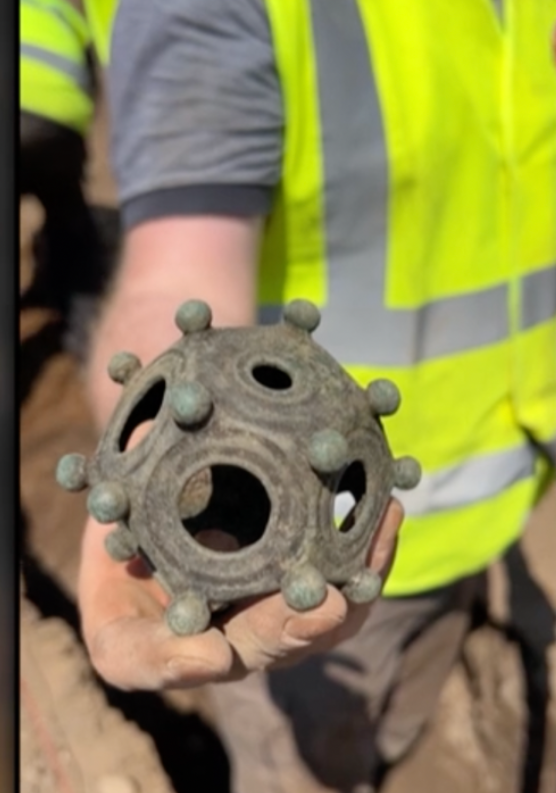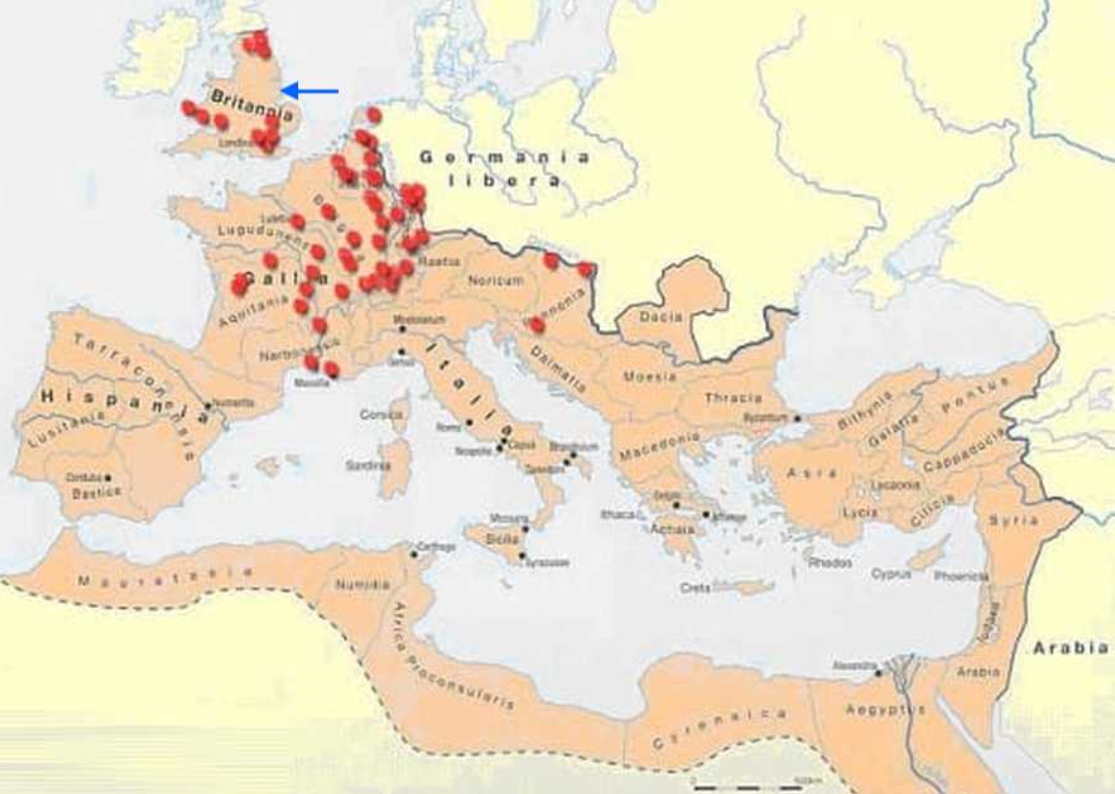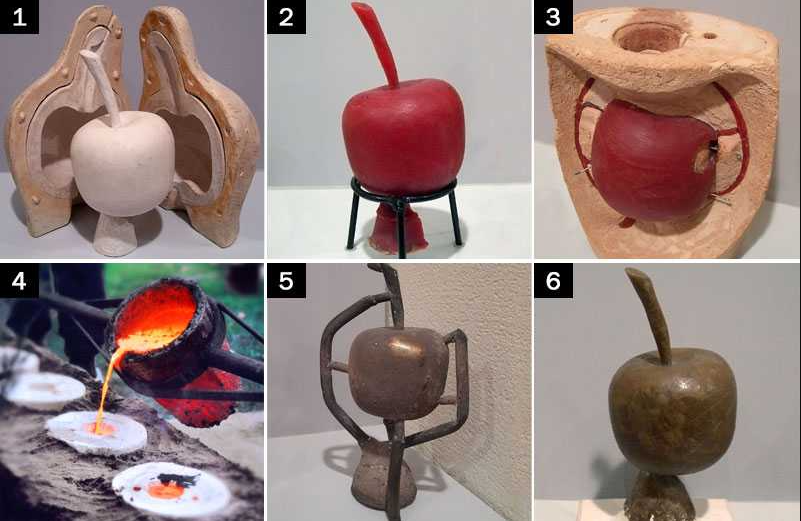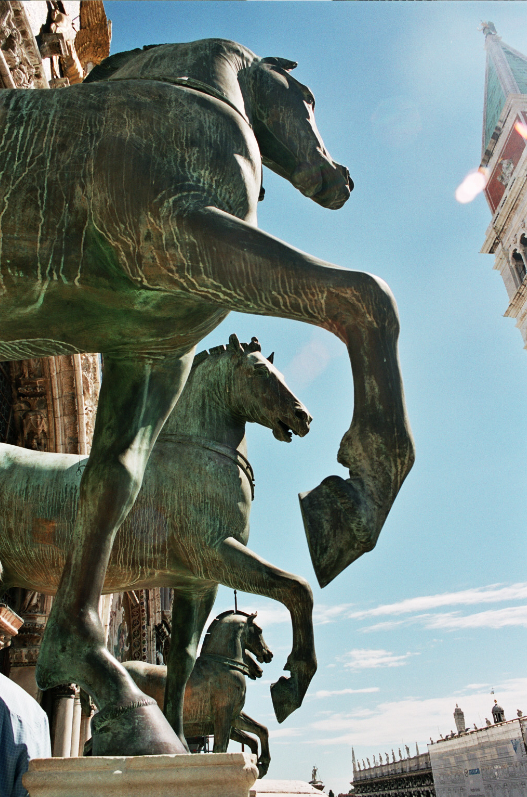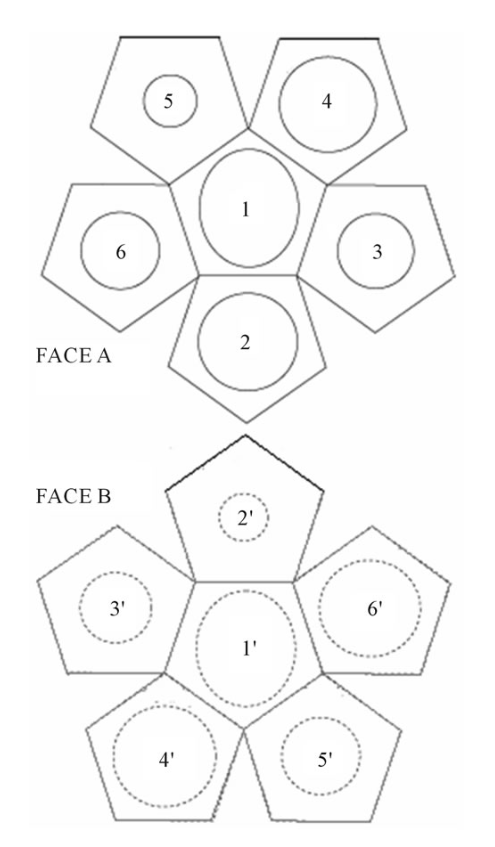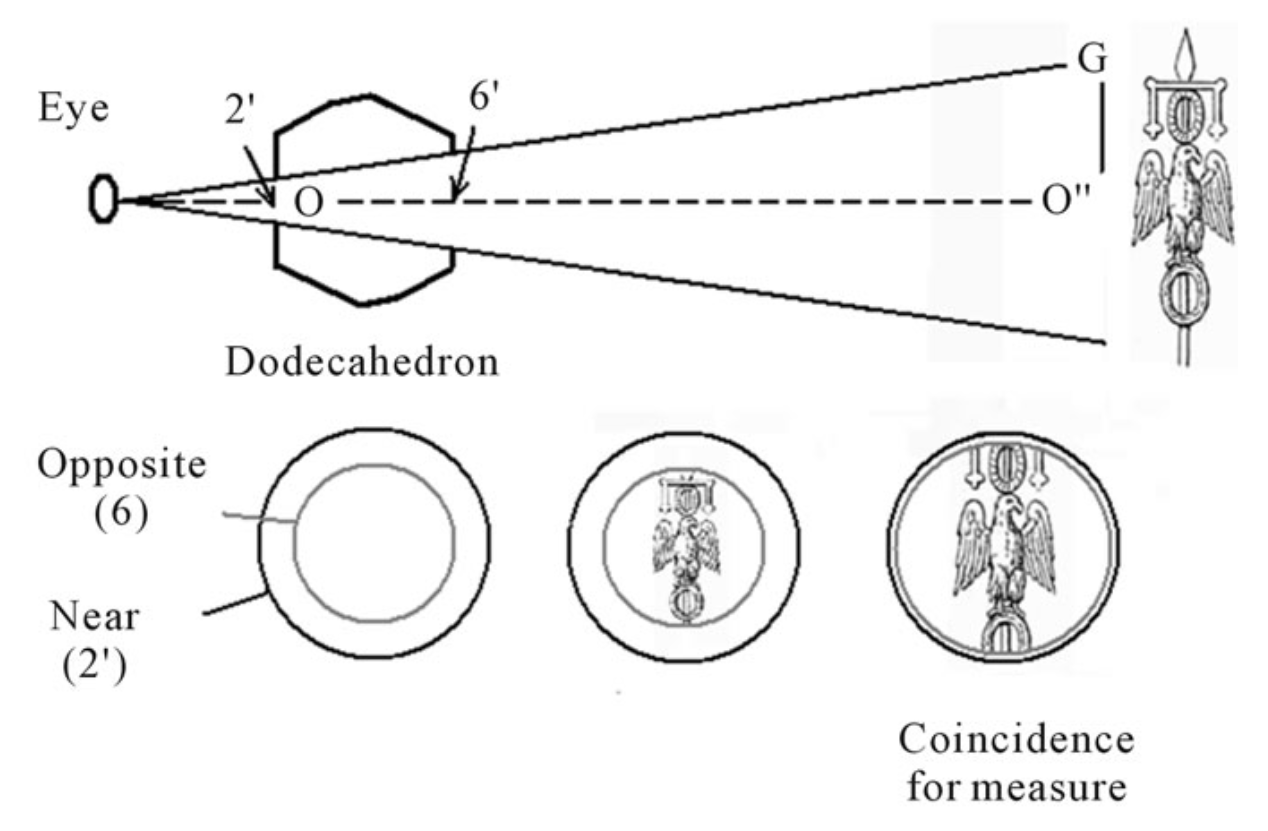The Die is Cast…or is it?
Fig.1 Gallo-Roman dodecahedra from the Rheinishche Landesmuseum in Bonn.
Small enough to fit into the palm of your hand (ca. 4 cm-11cm), these mysterious bronze objects with 12 pentagonal faces have been enthralling audiences with their elusive function for centuries (Fig.1). Over 130 Roman dodecahedra have been unearthed in various sites across northern Europe, including 33 in Britain. Capturing the imagination of historians, archaeologists, artists, mathematicians, engineers, gamers and knitters, a dozen theories have emerged: a ritual object to a candle holder, a gaming die, a device for calculating distances, to a frame for knitting gloves (and many more).
When I began researching Gallo-Roman dodecahedra for a documentary (Strangest Things (2021 S.1 ep. 2) sorting through theories was like unravelling a tangled tapestry: varying specialisations made it difficult for any individual to provide a critical assessment. I cannot provide a definitive answer (I prefer to let readers decide), but I hope to combine my skills as a scholar of inscribed Roman objects (an epigrapher) and experiences in Romano-British archaeology to illustrate how one might navigate the swarm of online theories. This requires careful consideration of appearance (shape, & material), how these objects were made, and where they were found (location, context, and associated materials), which will then be critically applied to some of the theories. I hope the information and methodology are helpful, not only for understanding dodecahedra but for assessing many curious objects.
Part I. Facing the Problem. Roman Dodecahedra: What, when, where & how?
What & When:
On June 28th 1739, Mr. North wrote a report to the Society of Antiquaries in London about a 12-faced metal object with a series of holes that he found alongside coins in Ashton, Hertfordshire. The complexity and detail of these shapes are astounding, each of the 12 sides has a different size circle hole and a corresponding (smaller) hole across the diameter. The varying size of the circles is sometimes marked by etchings (Fig 2).
Fig. 2 From BBC Digging for Britain (Season 11, Episode 4).
Each pentagonal face is fitted with nodules on the end, which make it look like an odd cross between a Rubik’s cube and a game of jacks. They are not recorded in literary or material sources and without understanding their role it is difficult to know where to look. Many appear in good condition without wear, though some nodules tops can appear a bit smoother/shinier. Bronze, a copper alloy, was expensive (used for coins) and the process of casting the intricate design and shape must have been difficult.
300 years later, these puzzling objects, which date to the 2nd- 4th centuries AD, continue to emerge. One was found last year (Fig. 3), the first example from the Midlands, in a 4th-century quarry pit near a Roman villa by the village of Norton Disney, 12 miles southwest of Lincoln. Reports of this find offer a rare perspective: the relative size of a dodecahedron in a hand and with smaller models: it is large (8 x 8.6cm) and, as heavy as a mobile phone or a baseball (254 grams).
Fig. 3 Map of find sites for Gallo-Roman Dodecahedra with the recent find in blue.
Where:
It is probably not coincidental that these objects, often described as “Gallo-Roman”, emerged in Northern Europe, a place with a long and distinguished history of metalworking and geometric designs. Findspots range from Hadrian’s Wall in the North to Arles (southern France). A distribution map (Fig. 3) illustrates an interesting aspect of the dispersion of these objects, especially near Hadrian’s wall: some seem to be associated with Roman camps. Some dodecahedra have been found in hoards or wealthy graves, attesting to their value. They have also been found in riverbeds, pits, a luxury shop, public buildings and a temple.
How:
The casting of these objects was no small feat. A common metalworking technique in the 2nd -3rd centuries AD that may be thousands of years old, “lost wax casting” used a wax model that was baked in clay. When the wax melted, it left a space in the clay mould where metal could be poured. For solid objects, this was a straightforward process but designing a mould for a hollow object with 12 pentagonal faces would have been costly in time and resources. The process was used on famous statues, like the quadriga (horses) at Basilica S. Marco, Venice, taken from the Hippodrome at Constantinople. “Strangest Things” explored this further and the Victoria and Albert Museum has a video.
Fig. 5 Quadriga in Piazza S.Marco, Venice
Let us sum up what we know about Roman Dodecahedra
• Their design was complex: 12 unique pentagonal faces of 6 parallel sets of circles.
• They have been found exclusively in Northern Europe, often in/around Roman camps, and in association with other valuable objects (coins etc) and/or wealthy burials.
• They were very expensive in terms of material and production.
Part II. The Role of the Die: Assessing Theories of the Dodecahedron
Why do you doubt your senses?: Warnings for a modern reader.
As humans, our attempts to make sense of the world can be both a help and a hindrance. When an object looks like something we know, our first instinct is to ‘recognise’ it. When we are lucky, pieces (appearance, material, context and function) fit together: A Roman coin may look similar, be made from similar materials, and be found with other valuables in a hoard. However, visual similarities can be false friends. Some theories suffer from this bias, so we need to assess theories against practical constraints and what we know about these objects.
I have selected some popular and intriguing theories, since I cannot cover them all!
Theory 1: For a Dice Game or a Child’s Toy
Gaming has a long history in ancient Rome from Caesar’s words as he crossed the Rubicon to Cicero’s (Philippic 5) derogatory description of Mark Antony as “Aleator” (idle gamer). Similarities in size, shape and decoration inspired ideas that dodecahedra are for games.
Appearance: Looks vaguely similar.
Material: Metal is fairly unusual for dice.
Context/Location: Gaming was popular across the Roman world, so why are these only in N. Europe? Dice are seldom found in hoards or wealthy graves.
Use: They don’t work as dice: they are unequally weighted (“loaded dice”); they do not roll properly with nodules, which would likely bend after many tosses.
Toy: Would you give a child a valuable mouth-sized metal object to toss around?
Conclusions: Appearance and location have some relevance to this theory, and there is an historical background for gaming, but the pieces do not fit together.
Theory 2: A Candlestick
The wax found inside some of these objects led to a theory that they were candlesticks, used in the North (where olive oil was not as easily accessed?). Leftover wax inside the shapes may also be expected from the “lost wax” casting process.
Appearance: Not similar to a candlestick: there is no handle or area for wax to pool.
Material: Roman candelabra can be bronze, but size, shape & design are different.
Context/Location: Oil lamps survive across Northern Europe, including forts near Hadrian’s wall like Arbeia. Roman candelabra emerge only rarely in graves or in hoards.
Use: They would have left a big mess: the nodules are not sufficient for a good grip and do not protect a hand from hot dripping wax. Cleaning would be a nightmare!
Conclusions: For the value and cost, this would have to be the best candlestick ever, and the design suggests otherwise. Use and material may fit the location, but not the context or appearance.
Theory 3: Knitting Gloves
This is the most popular theory, promoted enthusiastically by people who have put it into practice; they deserve credit for ingenuity and considering location & use.
Appearance: Yarn could be wrapped around nodules and knitted fingers placed in the holes like a knitting dolly. I’m not an expert on Roman knitting, but the device looks very different from the tools I’ve seen.
Material: Knitters' reconstructions are 3-D printouts: many are made a bit larger to fit bigger hands. Were small versions only for ladies and children; and why 6 finger holes? Knitting gloves with a precious tool seems like using a Roman fibula (cloak pin) as a hair elastic: form and function do not quite fit. Was a wealthy woman likely to knit her own gloves?
Context/Location: There is a long tradition of wool-working and knitting across the Roman world but everyday objects (needles, spindles, socks) are seldom found in hoards or elite burials. Why were valuable devices limited to settlements in Northern Europe and seldom associated with domestic objects or spaces?
Use: Videos illustrate a modern use for a Gallo-Roman dodecahedra but was this their true function? Consistent use may have worn down places where wool was wound or placed inside the circles, but no such wear is evident.
Conclusions: It is difficult to weave a cohesive narrative between material, context and use. The dissonance between the value of these objects and what they produced is difficult to reconcile, as is the context and lack of association with domestic spaces or objects.
Theory 4: A Ritual Object
In archaeology “ritual object” often translates to “we I have no idea what this is”. The term seems appropriate here and is favoured by many scholars as it leaves possibilities open.
Material: Metals and metalworking in Northern Europe pre-date Roman occupation, ‘Gallo- Roman’ inhabitants had both the raw materials and the artisans to produce these objects, as well as native deities and rituals. Lead and tin were used ritual objects like curse tablets at Bath & Uley, which employ some Gallic names and deities.
Context and Location: Associations with Roman military sites were not necessarily limited to Roman culture or religion: Roman soldiers were recruited across Europe. Accounts from Hadrian’s Wall attest to Legions recruited from areas in modern Belgium, Switzerland, France, Holland, and Austria. Many deities and rituals were regional and the distribution of dodecahedra across Europe could reflect widespread cultural migration.
Use: Rituals are mysterious and seldom written down, so discussions are often speculative. It has been suggested that parallel circles, which tunnelled the vision, could be stargazing or reading seasons, or that the tactile experience of holding and turning it was “mediative”.
Conclusions: Material and context line up fairly well, though the broad-scale distribution of a regional cult or ritual may be unusual, it is possible and, given the nebulous nature of our ritual knowledge, is difficult to prove or disprove. Use in a Gallo-Roman ritual could explain the exclusion of these objects from Roman sources but questions remain: why do they only emerge in the 2nd -4th centuries AD, often outside ritual contexts?
Theory 5: A Range for Calculating Distance
Professor A.C. Sparavigna (Applied Science and Technology at Torino University) suggests a practical use of dodecahedra as ranges to measure distance. Think of the opening scene of the film Gladiator (2000): a Roman army is attacked in Northern Europe by a swathe of warriors, tension builds as they wait for the precise moment that the attackers come within range of the artillery. Distance measurements allowed one to calculate exactly when adversaries were in range: portable devices could be used on the battlefield. This theory is complex, involving a level of Physics that I cannot critically assess. An online article sets out how the device could work, using equations, images and a vexillum (flag). (Figs 6-7) to calculate 4 distances and a model based on a dodecahedron from Jublains, France (Roman Noiodunum).
Fig. 6 Taken from A.C. Sparavigna’s 2012 online publication (see link in text).
Fig. 7 Taken from A.C. Sparavigna’s 2012 online publication (see link in text).
Material: This theory could explain the strange shape of the dodecahedra, the varying sizes of the parallel circles and differentiating marks. Metal was required for durability and precision: many Roman measuring devices required metal weights (the groma) and or dials (the dioptra). Variation in composition may reflect local resources and/or production.
Context and Location: The emergence of dodecahedra in the 2nd century AD fits with military expansion and the consolidation of boundaries. A portable device for accurate measurements may have become desirable, especially at frontier forts, settlements and villas. An epitaph for L. Aebutius (late 1st c. AD), a land surveyor from Italy (Ivre), portrays instruments that were in use for centuries across the Mediterranean by Roman, Egyptian, Greek and Punic surveyors, which may have been more scarce in Northern Europe.
Use: The device could have been developed for one purpose or project (e.g. the centuriation of land for a Cadaster at Arausio (Orange) under Vespasian) collaborating with Gallic craftsman, then disseminated by the Roman army or Romano-Gallic officials as a useful tool, which precluded specialised surveyors and/or their equipment.
Conclusions: Like a dodecahedron, there are holes permeating this theory. Variable sizes, which could attest to different workshops or specifications, remain puzzling. While L. Hitchens observed that variations in size preclude these objects from operating as gauges, variations do not impact the function of a range: as long as a similar ratio in the size of the parallel circles was maintained, the optical effect was achieved. It seems odd that none have been found outside Northern Europe nor in any Roman sources: strange and unique, dodecahedra seem worthy of comment. However, if they were easy to use and practical in function, they would hardly be the stuff of poetry, history, or art. Their spectacular shape would have been challenging to render in paint or sculpture, and their practicality makes them as elusive as an exotic ritual object.
To conclude…
As you can see, there is not one definitive theory. The two latter theories are appealing because each seems to fit along several categories. Both theories recognise a two-way cultural exchange and syncretism between Roman and Gallic cultures, worthy of the descriptor “Gallo-Roman”. Success in the Roman world was often a product of collaboration and ingenuity between different peoples, places, cultures and resources. Even without an answer, I hope discussions have demonstrated how we might deconstruct the theories and narratives, which often present more faces than A 12-sided object.
Further Reading (many links are provided in the text)
Ritual function: For a consolidation of scholarship see Prof. Tibor Grüll’s (2016) chapter “The Enigma of the Dodecahedron”: 148-156.
Rangefinder: You can read a simplified version:“An Ancient Rangefinder for Teaching Surveying Methods,” https://www.scirp.org/html/9-8101677_23245.htm#Figure%209
Or download a longer publication: “A Roman Dodecahedron for measuring distance,” https://arxiv.org/abs/1204.6497
Astronomic grain theory? Another theory is significantly more complex than a rangefinder, but also problematic in application. There was no time to discuss it here, but it is an interesting read: https://www.romandodecahedron.com/the-hypothesis
About Abigail Graham
I am a British American who specialises in Roman Epigraphy and Archaeology. I was a lecturer and teaching fellow at the University of Warwick (2006-2019) and I am a research fellow at the Institute for Classical Studies and the British School at Rome, where I founded the Postgraduate course in Roman Epigraphy (2012-present).
My research involves Cognitive Approaches to Epigraphy, Monumentality, Public Writing, Lived Experiences, and how we can use Sensory Approaches to bring ancient inscriptions to life, making them more accessible to students, teachers, neurodiverse readers and academics across disciplines. To this aim, I've written several articles, book chapters, and a textbook "The Romans: An Introduction" (Routledge) as well as a free, open-access, online resource on Roman inscriptions for the Classical Association. My co-edited volume on ritual experiences is coming out this month with CUP.
I've also presented for documentaries: Empire Builders (PBS); Strangest Things (seasons 1-2: Discovery/Science Channel); Cracking the Code (Sky History), and radio (BBC 4).


